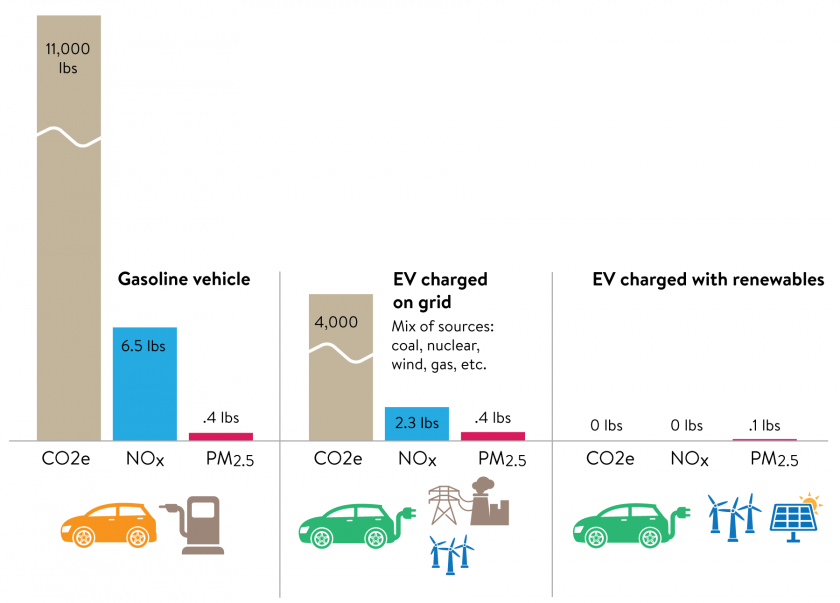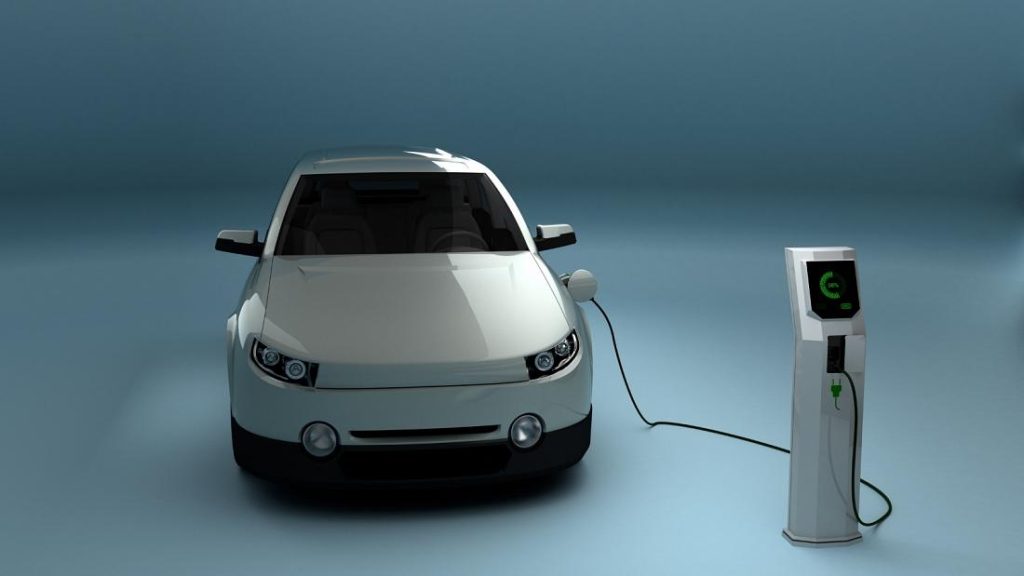Can Electric Vehicles Charge our Future?
By Parker Profet, 2021-2022 Environmental Leader
The necessity of everyday transportation has an increasingly negative environmental impact. Carbon emissions are continually rising; in turn, global warming is as well. Automobiles have the power to shape our environment. To date, gas and diesel vehicles have been our primary option, and our environment has suffered.
According to National Geographic, around 80 to 90 percent of an automobile’s environmental impact is fuel consumption and carbon emissions (9). As carbon becomes trapped in our atmosphere, our earth’s surface is warmed. Consequently, ice caps melt, sea levels rise, and animal habitats perish. In addition to the environmental impact, vehicle pollutants cause safety issues. Particulate matter, volatile organic compounds, and sulfur dioxide all induce risks to the respiratory system, primarily the lungs. Other chemicals can cause reduced brain function and immune system deficiencies (3). The effects of both diesel and gas vary. Diesel cars emit much less carbon emissions than gas but are a larger contributor to particulate matter.

Image Source: Minnesota Pollution Control Agency (4)
A practical alternative to combat pollution from gas and diesel are electric vehicles (EVs). EVs may still produce carbon emissions; however, the amount pales in comparison to the emissions of gas and diesel vehicles. Driving does not directly cause pollution. In reality, manufacturing batteries, producing cars, and generating electricity, are the primary pollutants (10). If these external sources of pollution were created using non-renewable energy, EVs would become decarbonized.
Since the Volkswagen (VW) Settlement in October 2016, EV production has amplified. VW violated the Clean Air Act by producing vehicles that emitted over the allowed amount of carbon emissions. As a condition of the settlement, VW allocated $14.7 billion into promoting EVs (11). Development is rapidly coming to the D.C., Maryland, and Virginia (DMV) area; multiple companies are constructing new charging stations. Electrify America, for example, is a company focusing on creating new electric charging stations to incentivize the use of EVs. The company plans to implement nine new charging stations in the DMV, four of these will be in Montgomery County, MD. In a talk with the Account Coordinator at Electrify America, Sage Feiler, she stated all sites will be in places of convenience, like retail stores and shopping malls. The placement allows the user to charge their vehicle while shopping or getting food. Furthermore, Feiler said the chargers are universal to all cars. The cost of charging is dependent on the speed of the charger.
State Governments are promoting EVs. The VW settlement portioned $2.7 billion for state-level projects in reducing emissions (1). Of Maryland’s $75.7 million received, around 15% was put into EV charging infrastructure. Zero-emission infrastructure plays a large role in promoting the use of electric vehicles. On August 30th, Maryland Governor Larry Hogan announced the use of $3.7 million to fund 36 new locations of business and public charging locations by the end of this year (6). The second round of funding will start at the beginning of 2022, with that there is more opportunity for EV infrastructure (1).
Some consumers are skeptical of EV’s practicality, the most prominent concern being range anxiety, which is the fear of running out of battery and being stranded. An EV median battery range is 259 miles, roughly the same as a gas-powered vehicle’s fuel capacity (7). Within those 259 miles of driving, it is almost a guarantee that a charging station will be available. What about driving long trips? Many charging companies have apps that allow users to plan a drive to find the most convenient charging location.
As seen in the ChargePoint map above, thousands of charging stations exist in and around Montgomery County. The image depicts free and paid public charging stations, high-speed charging stations are in orange, other public charging stations are in green. Many different apps like ChargePoint exist to help drivers locate the closest charger for their vehicle. In addition, these apps allow users to filter by price, speed, and charger type.
Not only do EVs provide a possibility of a decarbonized grid, but they are also more cost-effective. Gas for an average driver is more than twice as expensive as EV charging. Each year, consumers will save around $1000 in fuel costs by switching from gas to EV (12). Further, a federal rebate exists to gain $2500-$7500 in a tax credit upon purchasing an EV (5). Companies are continually creating many new affordable options. EVs are a better choice environmentally, as well as from a health and economic perspective. Make sure to consider EVs when purchasing a new vehicle.
References:
- Atiyeh, C. (2020, November 14). Everything you need to know about the VW diesel-emissions scandal. Car and Driver. Retrieved November 18, 2021, from https://www.caranddriver.com/news/a15339250/everything-you-need-to-know-about-the-vw-diesel-emissions-scandal/.
- Bateman, T. (2021, September 17). Europe’s carmakers are switching to electric. here’s when it’ll happen. Euronews. Retrieved November 18, 2021, from https://www.euronews.com/next/2021/09/16/when-will-cars-go-fully-electric-the-europe-based-carmakers-dropping-petrol.
- Cars, trucks, buses and air pollution. Union of Concerned Scientists. (2008). Retrieved November 18, 2021, from https://www.ucsusa.org/resources/cars-trucks-buses-and-air-pollution.
- Electric vehicles. Minnesota Pollution Control Agency. (2021, July 14). Retrieved November 18, 2021, from https://www.pca.state.mn.us/air/electric-vehicles.
- Enel X North America. (n.d.). Home. Electric Car Tax Credits, Incentives & Rebates by State | Enel X. Retrieved November 18, 2021, from https://evcharging.enelx.com/resources/federal-and-state-electric-vehicle-incentives.
- Manthey, N. (2021, August 30). Maryland to spend $3.7Mn from Volkswagen Settlement. electrive.com. Retrieved November 18, 2021, from https://www.electrive.com/2021/08/30/maryland-to-spend-3-7mn-from-volkswagen-settlement/.
- Moloughney, T. (2021, January 6). The median range of fully electric vehicles exceeded 250 miles in 2020. InsideEVs. Retrieved November 18, 2021, from https://insideevs.com/news/464449/median-range-evs-2020-exceeded-250-miles/.
- PlugShare. (n.d.). Retrieved November 18, 2021, from https://www.plugshare.com/.
- Staff, N. G. (2021, May 3). The environmental impacts of cars explained. Environment. Retrieved November 18, 2021, from https://www.nationalgeographic.com/environment/article/environmental-impact.
- Does an electric vehicle emit less than petrol or diesel?. Campaigning for cleaner transport in Europe | Transport & Environment. (2021, July 25). Retrieved November 18, 2021, from https://www.transportenvironment.org/discover/does-electric-vehicle-emit-less-petrol-or-diesel/.
- Maryland Volkswagen Mitigation Plan. Maryland Department of the Environment. (n.d.). Retrieved November 18, 2021, from https://mde.maryland.gov/programs/Air/MobileSources/Pages/MarylandVolkswagenMitigationPlan.aspx.
- Vehicle cost calculator. Alternative Fuels Data Center: Vehicle Cost Calculator. (n.d.). Retrieved November 18, 2021, from https://afdc.energy.gov/calc/.
About the Author:

Parker Profet, 2021-2022 Environmental Leader
Parker is a Senior at Walt Whitman High School and is planning to study Industrial Engineering in college. He is excited to learn how he can better help protect the environment through the Environmental Leaders program. He hopes to apply what he learns to his future career in the industry. Specifically, he is intrigued by advances in electric vehicles and their role in reducing carbon emissions.




 Map Source: PlugShare (8)
Map Source: PlugShare (8)

